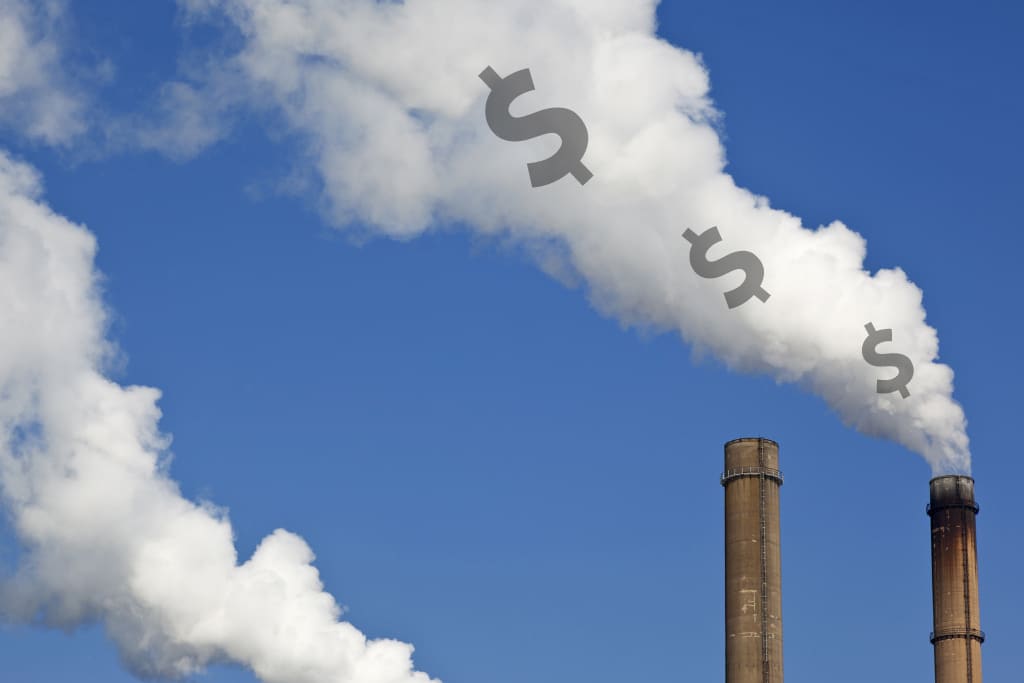The notion of a carbon tax is a hot topic among many climate change activists, think tanks and policymakers. With the simple aim of encouraging corporations to invest in sustainable energy sources, it is difficult for proponents of carbon pricing to not be drawn to its implementation. However, this debate is so complex that even supporters of such a policy are divided on the way it should be enacted. Despite its success in some countries, its failure in others has indicated that this subject should be carefully and thoroughly debated, with legitimate concerns and criticisms addressed. These are just some of the pros and cons of a carbon tax.
__
As global temperatures continue to rise and ice caps continue to diminish, one thing is starting to become visibly clear: COP26 is not working in the way we had hoped, so we need to seek alternative means to monitor and reduce our carbon emissions.
In simple terms, a carbon tax imposes a price on the carbon emitted by countries and corporations. It puts the responsibility of the social cost of carbon pollution onto the individuals and firms that are emitting it. Enshrined in the “Polluter Pays Principle” established in the Rio 1992 Summit, a carbon tax’s aim is to reduce our carbon footprint, whilst also encouraging investment in environmentally friendly alternatives.
The fundamental logic of such a policy is that if you want less of something, you make it more expensive. An effective carbon tax would need to be high enough to encourage corporate polluters to change to sustainable options, whilst also being able to ensure they can maintain their future profitability. The tax itself should reflect the actual cost that it has on society. Recent research published by the think tank Resources for the Future established that even a modest price would significantly reduce carbon emissions, and a higher price would be able to cut them faster and further.
Carbon tax comes with its pros and cons; The debate for a carbon tax is a unique topic of interest as it unites people on the political left and right, yet the requirement for such a policy is divided. Proponents of the policy believe it to be the only effective way to hold corporations liable for their negligence, and encourage them to seek alternative low-carbon options. On the other hand, opponents of carbon pricing may not even believe that climate change exists, or might simply believe it to be a bad strategy that is dangerous to enact.
They also claim that this policy would be ineffective, as consumers may still be willing to pay the extra cost for the product that has been produced, regardless of the price increase. Demand may also be unchanged, as there are no substitutes for carbon-based commodities like electricity and petrol.
Carbon Tax Pros and Cons
1. Implementing the Policy
If a country were to implement a carbon tax, policymakers would need to take on the role of setting, monitoring, and enforcing the caps on greenhouse gas emissions, and to ensure they are thoroughly regulating the energy sector.
There are many arguments surrounding the implementation of such a policy, and whether the administration work and costs will be outweighed by the benefits needed to be taken into consideration.
Pros: The proponents claim this would be easy to administrate, as there are already special taxes in place in the energy sector that can be used as the foundation to the new carbon tax policy. If the policy were to be enacted, a large percentage of a country’s carbon emissions will be monitored and sanctioned. For example, a carbon tax could cover 98% of the US’ carbon dioxide emissions.
Cons: The opponents to the policy believe that it is impossible to guarantee that such a policy could be easy to enact, making it an unattractive option. Gaining the trust of the electorate is imperative if such a policy were to be enacted, but the political reality is that a tax will always be viewed with caution by the masses.
Other opponents believe that a carbon tax will have a “distortionary” effect on the free market, and could encourage the reduction of gross domestic product growth in a country. They also believe that the implementation of such a policy can cause a “leakage” effect i.e. businesses will relocate their productions and businesses overseas in countries where a carbon tax is not enforced. This however could potentially be solved by a carbon border tax, which is a tax on emissions attributed to imported goods that have not been carbon-taxed at source – a financial mechanism the EU hopes to implement in the next few years.
2. Setting the Price
Once the foundation of the policy has been drafted by legislation and interest groups, they will then need to agree on how to accurately value and price the carbon, to ensure transparency and fairness.
Some countries, such as the US, already have a “social cost” of carbon equation so determining the current social cost in certain countries may not be difficult. However, problems start to arise when agreeing upon the correct model to use for such a policy. Not only does the current value need to be taken into consideration, but the future metric ton value also needs to be determined. Therefore, the model that sets the price could either be based upon people anticipating a near-term crisis or not. People may become divided on how to draw up this model.
Pros: Those in favour of a carbon tax policy may not see this issue as particularly difficult, and policymakers should be able to find common ground and agree to a price when taking into consideration the social cost of carbon and its implementation.
The carbon tax could also be used to lower other taxes to ensure inflation and aggregate real income be left untouched. This could address the risk of what opponents have labelled as “greenflation”, where political damage may incur from a terrible tax policy in the form of rising prices to materials, such as metal and copper, that are essential to renewable energy technologies like solar and wind power.
Some also fear the possibility that it may harm international trade, however this argument is subjective to different countries, as it depends on who they are currently trading with. In the US, more than 80% of their trade is with countries who already have a carbon price in place, therefore this argument may not be particularly effective in the US.
There are also fears that some poor developing countries may suffer as a result of the policy, as some may not be able to afford the extra cost increases. However, carbon border adjustment tariffs can be put in place for countries that do or do not already have a carbon tax. This would depend on each individual case, but can alleviate the burden on developing countries, and can ensure countries that already have a carbon tax are not incurring further costs.
Cons: Some argue that there should be no price set at all, and that doing so will encourage the “leakage” issue that has been referred to above. These opponents may argue that such an economy-wide burden will create little change to the overall global trajectory of emissions as larger countries with no carbon tax regulations, such as China and India, may just grow larger and pollute more. This will then encourage industrial corporate polluters to relocate their operations to those countries, also known as “pollution havens”, therefore deeming the carbon tax counter-productive. Additionally, the high price could also encourage tax evasion and some firms may even try to hide their carbon emissions.
The price increase from the carbon tax would not be the only cost, some believe. There would be additional administration costs in measuring the pollution and collecting the tax itself. Therefore, this would reduce the efficiency and productivity of the tax.
3. Distributing the Revenue
Finally, once the policy has been drafted and the price has been set, a decision needs to be made on the best method to distribute the revenue that has been collected.
Many have argued against a carbon tax policy on the basis that it is “regressive” i.e. it hits lower-income families the hardest. Additionally, the burden may not be evenly regionally distributed, as some areas of a country may be more energy intensive than other parts of the country. For example, in the US, the tax burden would be unevenly distributed as it would affect workers more in states with more energy intensive industries, such as Illinois, Ohio, Michigan, and West Virginia.
They believe that rather than a carbon tax, it would be beneficial to give benefits to firms producing sustainable commodities rather than impose a sanction on the ones that are not. These benefits can take the form of tax breaks or regulations on pricing to ensure that they are kept affordable.
This third issue is where the proponents can become divided. As there is no clear natural solution, some believe that the revenue should be used to address other societal issues that are not just limited to the environment, whilst others believe it should be invested into low-carbon technology research and development, and it’s also been argued that it should be returned to the electorate in the form of a tax rebate.
You might also like: Carbon Tax: A Shared Global Responsibility For Carbon Emissions
4. Address Societal Problems
Many progressives believe that the revenue collected should be used to address other societal problems that are not just limited to environmental issues. These can go as far as covering health inequality and be used towards other governmental spending priorities.
However, some may argue this to be unfair as it does not rectify the “regressive” issue, and other supporters of the carbon tax believe that the money should be restricted to climate change alleviation only.
5. Invest in Low-Carbon Technologies
Many other proponents believe that the generated revenue should be invested back into low-carbon technological research and development. Not only will this provide additional support to the country’s climate change budget, but will also encourage companies to convert their operations to low-carbon technologies and influence them to invest into more environmentally friendly options.
Although grounds for this argument are sound, it still does not tackle the issue of lower-income socioeconomic families being hit the hardest.
6. Return to the Electorate
Realistically speaking, imposing a carbon tax has a high possibility of hitting families from lower socioeconomic backgrounds harder. The Congressional Budget Office in the US noted that there will be an increase in costs for households. They released a report stating that “ a carbon tax policy that set a price of USD$28 per metric ton on CO2 emissions would increase costs for households by amounts that would equal about 2.5% of after-tax income for the average household in the lowest one-fifth (quintile) of the income distribution but less than 1 % of after-tax income for the average household in the highest quintiles.”
A reasonable solution to rectify the regression issue would be to return the revenue to the poorer, hard-hit families in the form of a Wealth Distribution Scheme. Although this may appear like an excellent solution to the problem, this may also be difficult to enact, as this method of redistribution may not be supported by conservatives.
Many conservative supporters of the policy may only support the implementation of a carbon tax if it were to be “revenue neutral” i.e. they believe that a change in tax law should not result in a change in the revenue coming into the government’s office. This is premised on the idea that a carbon tax will only make sense if it “offsets the tax burden on corporations and is part of a broader set of reforms that simplify the tax code”.
What Countries Have a Carbon Tax?
A carbon tax is not a new concept to adopt. As the World Bank reported, 40 countries and 20 municipalities use carbon taxes, or other forms of carbon emissions trading. This covers approximately 13% of greenhouse gas emissions produced globally.
They also reported in 2018 that 88 countries intend to use a carbon tax to meet their Paris Agreement goals in the future. This represents 56% of global emissions. In addition, there are 51 regional and local initiatives. The COP26 UN climate summit adopted the Glasgow Climate Pact, which laid down rules for a global carbon market for the first time, which has the potential of unlocking trillions of dollars worth of investments into clean energy, green technologies and financing resilience and adaptation measures in the developing world.
Successful Cases
The United Kingdom – In 2013, following a carbon tax of approximately USD$25 per ton, the use of coal sharply decreased. It was found that UK greenhouse gas emissions were at their lowest level since 1890.
Canada – In 2008, British Columbia introduced a charge on carbon. In the first four years of the scheme, it was found that fossil fuels had decreased by more than 17%.
Sweden – Since the mid-1990s, emission levels in Sweden have fallen by 20%, whilst still able to maintain a period of strong economic growth. This was due to a carbon tax of EUR€33 per ton being introduced in 1991, which over time increased to EUR€120 per ton, with discounted rates being offered to corporations in the manufacturing, agriculture and forestry sectors.
Cases of Failure
Australia – Due to a lack of political understanding and poor communication on who would benefit from it, Australia’s carbon tax that was introduced in 2012 was quickly abolished in 2014. Although the carbon tax they implemented met equity and efficiency goals, it did not succeed, as its political communication failed. What is interesting in this case is that carbon emissions did significantly decrease when the tax was in place, and they significantly increased after the tax was abolished. This clearly demonstrates that politics and the way in which the purpose of the tax is communicated to the electorate are important factors to consider when deciding to draft a carbon tax policy.
You might also like: Benefits of A Carbon Tax: A Shared Global Responsibility For Carbon Emissions














